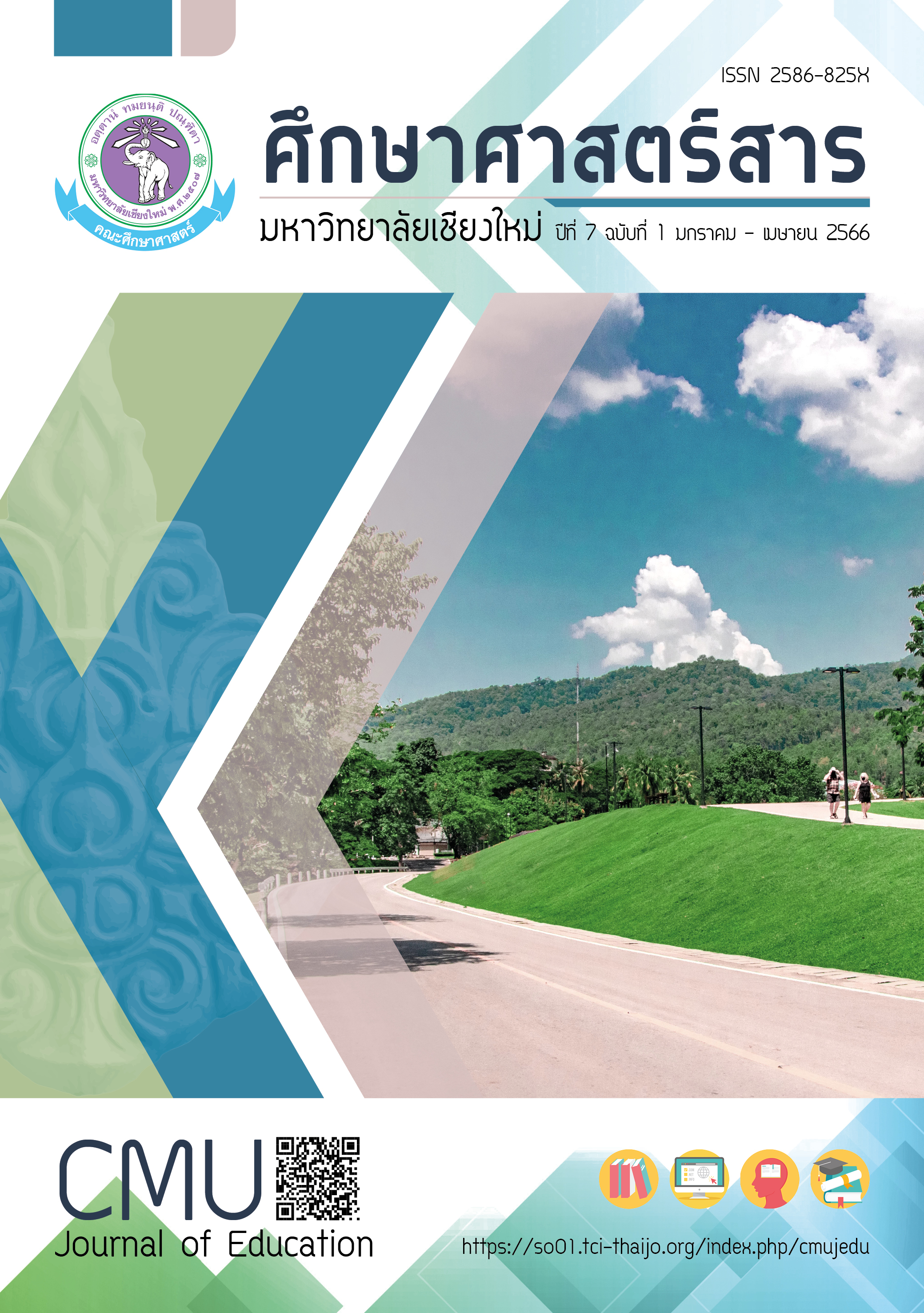นวัตกรรมแฟ้มสะสมงานอิเล็กทรอนิกส์ในการฝึกประสบการณ์วิชาชีพศึกษาศาสตร์: การศึกษาการรับรู้และการสะท้อนคิดของผู้ใช้
Main Article Content
บทคัดย่อ
งานวิจัยนี้มีวัตถุประสงค์เพื่อศึกษาการรับรู้และการสะท้อนคิดของผู้ใช้นวัตกรรมแฟ้มสะสมงานอิเล็กทรอนิกส์ในมิติต่าง ๆ ระหว่างการฝึกประสบการณ์วิชาชีพศึกษาศาสตร์ คณะศึกษาศาสตร์ มหาวิทยาลัยเกษตรศาสตร์ ประชากรในการวิจัย ได้แก่ นิสิตฝึกประสบการณ์วิชาชีพศึกษาศาสตร์ประจำปีการศึกษา 2564 ใน 6 สาขาวิชา จำนวน 103 คน อาจารย์พี่เลี้ยงและอาจารย์นิเทศก์ของนิสิต จำนวน 82 คน รวมประชากรทั้งหมด 185 คน เครื่องมือที่ใช้ในการวิจัยได้แก่ แบบสอบถามการรับรู้ความเหมาะสมของแฟ้มสะสมงานอิเล็กทรอนิกส์ (ฉบับนิสิต และฉบับอาจารย์) และแบบสัมภาษณ์กึ่งมีโครงสร้างเกี่ยวกับข้อดี ข้อจำกัด และข้อเสนอแนะในการปรับปรุงแฟ้มสะสมงาน (ฉบับนิสิต และฉบับอาจารย์) มีการตรวจสอบคุณภาพเครื่องมือโดยผู้เชี่ยวชาญด้านการศึกษา ผลการวิจัยพบว่า ผู้ใช้รับรู้ในความเหมาะสมของแฟ้มสะสมงานอิเล็กทรอนิกส์ในหลายด้าน โดยเฉพาะอย่างยิ่งด้านเกณฑ์การประเมินการฝึกประสบการณ์วิชาชีพ ด้านความสามารถในการสะท้อนผลการเรียนรู้ของนิสิต ด้านความทันสมัยและช่วยให้เกิดความสะดวกในการบันทึกข้อมูล ช่วยให้ประหยัดเวลาและค่าใช้จ่าย
เมื่อเปรียบเทียบกับการจัดทำแฟ้มสะสมงานแบบใช้กระดาษ ส่วนข้อจำกัดสำคัญคือการที่ระบบยังขาดเสถียรภาพ เกิดปัญหาการบันทึกข้อมูลและไม่สามารถแก้ไขข้อมูล รวมถึงการบันทึกข้อมูลคลาดเคลื่อนจากความเป็นจริง แนวทางการแก้ไขปัญหาที่สำคัญคือปรับปรุงเรื่องเสถียรภาพของระบบโดยผู้เชี่ยวชาญและแก้ไขส่วนต่อประสานกับผู้ใช้ที่สอดคล้องกับความต้องการของผู้ใช้ทุกฝ่าย
Article Details

อนุญาตภายใต้เงื่อนไข Creative Commons Attribution-NonCommercial-NoDerivatives 4.0 International License.
หากผู้เสนอบทความมีความจำเป็นเร่งด่วนในการตีพิมพ์โปรดส่งลงตีพิมพ์ในวารสารฉบับอื่นแทน โดยกองบรรณาธิการจะไม่รับบทความหากผู้เสนอบทความไม่ปฏิบัติตามเงื่อนไขและขั้นตอนที่กำหนดอย่างเคร่งครัด ข้อมูลของเนื้อหาในบทความถือเป็นลิขสิทธิ์ของ Journal of Inclusive and Innovative Education คณะศึกษาศาสตร์ มหาวิทยาลัยเชียงใหม่
เอกสารอ้างอิง
ชินัณ บุญเรืองรัตน์, ณัฐธยาน์ ทำดี, และณัฐวุฒิ เอี่ยมเนตร. (2565). ความสนใจในการเรียนออนไลน์ระบบเปิดหลังการแพร่ระบาดใหญ่ของโควิด-19 ใน 3 ประเทศกลุ่มอาเซียน: สิงคโปร์ อินโดนีเซีย และไทย. ศึกษาศาสตร์สาร มหาวิทยาลัยเชียงใหม่, 6(1), 29-43.
วิชญาพร อ่อนปุย. (2565). การจัดการเรียนรู้โดยใช้รูปแบบตามแนวคิด STEM Education เพื่อส่งเสริมทักษะการแก้ปัญหาและการตัดสินใจของนักศึกษาครู. ศึกษาศาสตร์สาร มหาวิทยาลัยเชียงใหม่, 6(1), 102-116.
ศูนย์ฝึกประสบการณ์วิชาชีพศึกษาศาสตร์. (2563). รายงานสรุปผลการฝึกประสบการณ์วิชาชีพศึกษาศาสตร์ ประจำปีการศึกษา 2562. กรุงเทพฯ: คณะศึกษาศาสตร์ มหาวิทยาลัยเกษตรศาสตร์.
Azidah, A. Z., Muhammad, F. A. R., Fadzilah, A., Adu, E. I. (2020). Using e-Portfolio to Develop IMT Skills among Trainee Teachers in a Malaysian University. Universal Journal of Educational Research, 8(10), 4470 - 4477.
Berbegal, V. A., Merino, O. A., Arraiz, P. A., & Sabirón, S. F. (2021). The e-portfolio in higher education: The case of a line of teaching innovation and complex change management. Tuning Journal for Higher Education, 9(1), 29-64.
Campbell, C.; Tran, T.L.N. (2021). Using an Implementation Trial of an ePortfolio System to Promote Student Learning through Self-Reflection: Leveraging the Success. Education Science, 11, 263.
Carl, A., & Strydom, S. (2017). e-Portfolio as reflection tool during teaching practice: The interplay between contextual and dispositional variables. SA Journal of Education, 37(1), 1250.
Colás-Bravo, P., Magnoler, P., & Conde-Jiménez, J. (2018). Identification of Levels of Sustainable Consciousness of Teachers in Training through an E-Portfolio. Sustainability, 10(10), 3700.
Harun, R. N. S. R., Hanif, M. H., & Choo, G. S. (2020). The pedagogical affordances of e-portfolio in learning how to teach for Teacher Education Programs: A systematic review. Studies in English Language and Education, 8(1), 1-15.
Hegarty, B., & Thompson, M. (2019). A teacher’s influence on student engagement: Using smartphones for creating vocational assessment ePortfolios. Journal of Information Technology Education: Research, 18, 113-139.
Helen, B. B., Joje, M. P S., Vincent, T. M. B., & Tizza, M. M. N. (2022). Utilization of e-Portfolios in Teacher Education Institutions of Higher Education in Central Visayas, Philippines. International Journal of Information and Education Technology, 12(9), 912-920.
Holtzman, D. M., Kraft, E. M., & Small, E. (2022). Use of ePortfolios for making hiring decisions: a comparison of the results from representatives of large and small businesses. Journal of Work-Applied Management, 14(1), 18-34.
Hunt, P., Leijen, Ä., & Van der Schaaf, M. (2021). Automated Feedback Is Nice and Human Presence Makes It Better: Teachers’ Perceptions of Feedback by Means of an E-Portfolio Enhanced with Learning Analytics. Education Science, 11, 278.
Janssens, O., Haerens, L., Valcke, M., Beeckman, D., Pype, P., & Embo, M. (2022). The role of ePortfolios in supporting learning in eight healthcare disciplines: A scoping review. Nurse Education in Practice, 63, 103418.
Karami, S., Sadighi, F., Bagheri, M. S., & Riasati, M. J. (2019). The Impact of Application of Electronic Portfolio on Undergraduate English Majors’ Writing Proficiency and their Self-Regulated Learning. International Journal of Instruction, 12(1), 1319-1334.
Korhonen, A.-M., Ruhalahti, S., Lakkala, M., & Veermans, M. (2020). Vocational Student Teachers’ Self-Reported Experiences in Creating ePortfolios. International Journal for Research in Vocational Education and Training, 7(3), 278–301.
Lilly, T., & Cooper, R. (2021). Getting to Eportfolios Through Assessment: A Process Model for Integrating Eportfolio Pedagogical Concepts Through Training for Program Assessment. Journal of Higher Education Theory and Practice, 21(7), 44-55.
McDermott-Dalton, G. (2022). Putting the ‘e’ in portfolio design: an intervention research project investigating how design students and faculty might jointly reimagine the design portfolio activity. International Journal of Technology and Design Education, 32(2), 1207–1225.
Mitchell, L., Campbell, C., Somerville, M., Cardell, E., & Williams, L. T. (2021). Enhancing graduate employability through targeting ePortfolios to employer expectations: A systematic scoping review. Journal of Teaching and Learning for Graduate Employability, 12(2), 82-98.
Mudau, P. K. (2021). Lecturers' Views on the Functionality of e-Portfolio as Alternative Assessment in an Open Distance e-Learning. International Journal of Educational Methodology, 8(1): 81-90.
Nicolls, B., Cassar, M., Scicluna, C., & Martinelli, S. (2021). Charting the competency-based eportfolio implementation journey. In Domenech (Ed.), 7th International Conference on Higher Education Advances. (pp.1409-1417). Val`encia: Universitat Polit`ecnica de Val`encia.
Novillo, P., & Pujolà, J. T. (2019). Analysing E-tutoring Strategies to Foster Pre-service Language Teachers' Reflective Practice in the First Stages of Building an E-portfolio. Universal Journal of Educational Research, 7(5), 1234 - 1246.
Piper, C. H. (1999). Electronic Portfolios in Teacher Education [Doctoral dissertation, University of the Pacific Stockton]. University of the Pacific Stockton, California.
Pourdana, N., & Tavassoli, K. (2022). Differential impacts of e-portfolio assessment on language learners’ engagement modes and genre-based writing improvement. Language Testing in Asia, 12(1), 7.
Roco, M., & Barberà, E. (2022). ePortfolio to promote networked learning: an experience in the Latin American context. International Journal of Educational Technology in Higher Education, 19, 37.
Romero, L., Saucedo, C., Caliusco, M., & Gutiérrez, M. (2019). Supporting self-regulated learning and personalization using ePortfolios: a semantic approach based on learning paths. International Journal of Educational Technology in Higher Education, 16, 16.
Segaran, M. K., & Hasim, Z. (2021). Self-regulated learning through ePortfolio: A meta-analysis. Malaysian Journal of Learning and Instruction, 18(1), 131-156.
Taberna, J., García-Planas, M., & Domínguez-Garcia, S. (2016). The use of e-portfolio in a linear algebra course. Journal of Technology and Science Education, 6(1), 52-61.
Van Ostaeyen, S., Embo, M., Schellens, T., & Valcke, M. (2022). Training to Support ePortfolio Users During Clinical Placements: a Scoping Review. Medical Science Educator, 32(4), 921–928.


